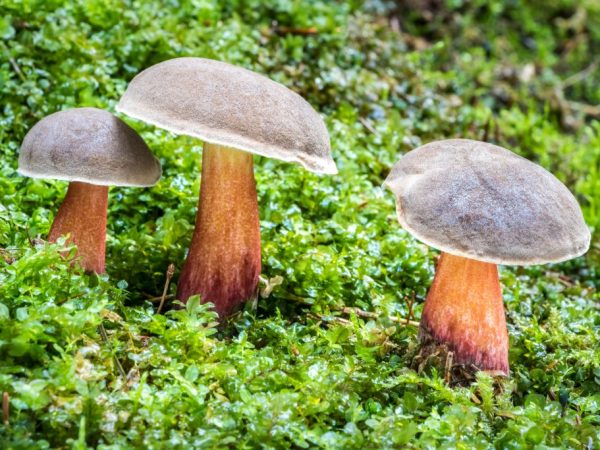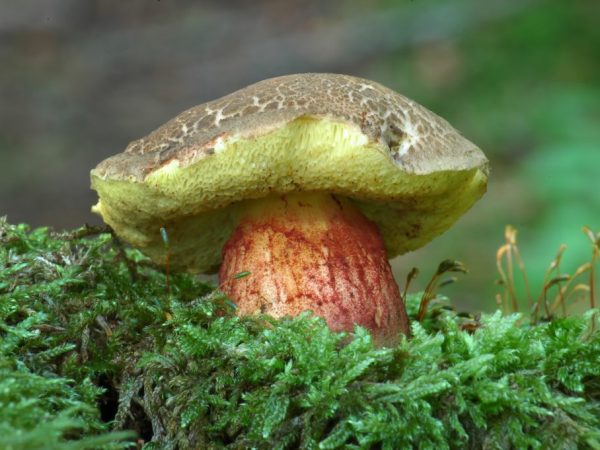Does the mushroom fly blue
Sometimes in the forests there are fungi growing in areas overgrown with moss. These are flyworms belonging to the genus Bolet. They got their name from their place of growth. Among them, there are species unsuitable for human consumption. To make sure whether the mushroom found is edible, determine whether the flywheel turns blue on the cut or not.

Does the mushroom fly blue
Distribution locations
Flywheels grow mainly in coniferous forests, and sometimes they can be found in mixed forests of temperate latitudes, on the slopes of ravines, at the bases or in the trunks of fallen trees. Most often they grow one at a time, less often - in small groups, forming a dense plexus of mycelium and moss. In addition to mycorrhizal species, soil saprotrophs are also present among the moss. Mass collection period: from early summer to late autumn. Among them there is an interesting species - parasitic flyworm, the place of residence of which is the fruiting bodies of pseudo-raincoats.
Varieties
In the world there are 18 species of Mokhoviks suitable for human consumption. They are classified according to their appearance. The most common are the following:
- Green moss: the cap has a greenish-olive color, the flesh is yellowish, the leg is thin, cylindrical in shape.
- Motley moss: differs from its counterparts in the cracked skin of the cap, through which the flesh of a pink hue and the leg of a yellowish color are visible. More common in mixed forests.
- Flywheel yellow-brown: it is characterized by a gray-orange hat, which is more convex in comparison with other types, darkens with age to a red-brown hue;
- Flywheel red: the size of representatives of this species is smaller than others, and plus it is also less common. Has a brighter reddish-brown color, especially young specimens.
- Powdered or blackened flywheel: in addition to the seeming dusty cap characteristic of a young mushroom, it has a peculiarity to sharply turn blue at a break, and then turn black.
- Pink-footed flywheel: the cap has a smooth brown-chestnut shade, and the stem is bright pink at the base.
- Velvet mosswheel: has the same color of the cap as Variegated, but without cracks.
Mushroom pickers sometimes confuse young specimens with boletus, and as they grow, the similarity with boletus increases.
general characteristics
Despite the existence of a large number of species of flyworms, they have common characteristics.
This is a typical representative of the group of tubular fungi with a porous inner (lower) part of the cap of a convex shape. Otherwise, we can say that these mushrooms have a tubular or spongy hymenophore. The diameter of the cap can reach 10-14 cm. It is dry and velvety to the touch in dry weather, and in wet weather it becomes sticky in some species. The leg is light, cylindrical, up to 8-10 cm in height. In a fungus growing in dry moss, it is short and thick, in wet moss, on the contrary, it is elongated and thin. The surface of the leg, depending on the type, can be smooth or wrinkled.The pulp is light yellow in color; if damaged, it turns blue and emits the aroma of needles.
Differences of a false flywheel

Edible Mosswheel turns blue when cut
The edible flywheel turns blue when cut. In addition to edible mushrooms of this type, there are those that are forbidden to eat. They are not poisonous, but their taste is extremely unpleasant:
- Chestnut Mushroom: young specimens are characterized by a brown cotton-filled leg, which becomes hollow with age. If damaged, the surface does not change color. The hat is red-brown.
- Pepper and gall mushroom: their difference from edible species of flywheel lies in the ability of the pulp on the cut to acquire a red tint. In addition, pepper mushrooms have an unpleasant, pungent taste.
- Parasitic flywheel, or m. parasitic: parasitizes on other mushrooms - pseudo-raincoats, they are distinguished by a small cap size - up to 5 cm.
Irina Selyutina (Biologist):
The parasitic flywheel in appearance very much resembles the green flywheel, differing from it, firstly, in its smaller size and, secondly, in the place of growth. This species is very rare, found in dry places, on sandy soils in woodlands, where hard deciduous trees are predominant. Here it grows on the fruiting bodies of pseudo-raincoats belonging to the species Scleroderma aurantium / It is known in Europe, North America and North Africa, on the territory of the Russian Federation it is found in the Smolensk region, as well as in Belarus.
By the way. In addition to the flyworm parasitizing on the fruit bodies of other species of mushrooms, the flyworm lives asteraceae. He chose the hygrometric starlet as his place of residence and is known in Japan.
The main difference between false mushrooms and edible ones is the absence of a blue tint at the site of damage to the fruit body.
Considering that there are false flyworms, sorting through the harvested crop, you should inspect the places of the cuts and make sure that they have a blue tint, typical for edible specimens. After a thorough examination, they are washed, cleaned, if desired, boiled or fried. They are also good for drying, pickling or salting. They are suitable for long-term storage and do not lose their taste when frozen.
Useful and harmful properties
In terms of their nutritional properties and taste, Mokhoviki belong to the third, not the most valuable category. Their calorie content is low and amounts to 19 kcal per 100 g, which makes them a dietary product, and in terms of amino acid content, they are not inferior to meat. In addition, they contain a lot of vitamins (C, A, D, PP and group B), essential oils, extractive elements, micro- and macroelements, for which they are valued in vegetarian cuisine, and they also contain enzymes that help to better absorb food.
Irina Selyutina (Biologist):
The whole flywheel is used for food - a leg and a hat. The skin is usually peeled off with a knife before cooking. The traditional way of preparing a flywheel is its hot salting, when the mushrooms are pre-poured with boiling water to avoid darkening and immediately after that they are dipped into boiling brine, and only enameled dishes are used. You can dry the mushrooms without rinsing in the oven, over the stove or in the sun, after cutting into pieces. This will give the dried mushrooms a pleasant light yellow color.
To better assimilate the mushrooms, it is better to chop them before cooking.
By the way. The pulp of mushrooms contains a large amount of compounds that are easily oxidized in air (react with oxygen), which darken very quickly, as a result of which the mushrooms acquire their unpresentable appearance. That is why peeled mushrooms should be immediately sent to water, into which 1 tsp is added to 1 liter of water. salt and 2 g of citric acid. This will protect your crop from browning.
Old mushrooms beginning to decompose (which is outwardly imperceptible) can cause harm to the body.They accumulate toxic waste products that can cause disorders of the digestive and nervous systems. In addition, like any others, they should be used with caution in large quantities for people with diseases of the gastrointestinal tract, severe allergies. Also, do not offer mushroom dishes to children under 3 years old.
Conclusion
Flywheels are not the last in the hierarchy of mushroom pickers' preferences. To get the maximum benefit and pleasure from the harvested crop, you should be careful about harvesting and remember the main feature: the false mushroom that is not edible on the cut does not turn blue. In addition, if you are not sure about the quality of the mushroom, leave it where you found it.



